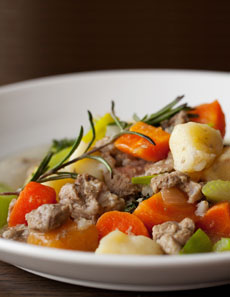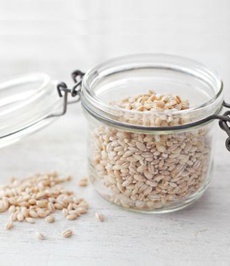TIP OF THE DAY: Irish Lamb Stew For St. Patrick’s Day
 [1] Irish lamb stew, made with pearled barley (all photos © Guinness).
|
If you like lamb, there’s no better excuse to make lamb stew than St. Patrick’s Day. Lamb shoulder, the best stew cut, is also far less pricey than lamb chops or leg of lamb.
This traditional dish is served on St. Patrick’s Day at the restaurant in Guinness Storehouse in Dublin, which provided the recipe below. Is so easy to make, that even a young cook can throw it together. The Guinness Storehouse is the original property leased in 1759 by Arthur Guinness for his brewery. It’s a 9,000-year lease, by the way, leading one to wonder if the landlord refused to write a 10,000-year lease. The property has been converted into a museum on the history of brewing and the history of Guinness. Note that the recipe cooks the meat and the vegetables for the same time. This creates soft vegetables, the old-fashioned style. If you prefer your veggies al dente, add in the vegetables after 45 minutes, but cook the full amount of stock from the beginning. Similarly, our mom always browned stew meat before adding it to the pot. Browning helps develop more depth of flavor; some cooks even brown the vegetables and herbs. This step isn’t required in Guinness’ recipe, so we didn’t do it; although next time we will for comparison. Serve the stew with a side of the pearled barley, some Irish soda bread and a Guinness (or brand of choice). While the stew is cooking, check out the different cuts of lamb. ________________ *See the last sections, below. |
|
|
Preparation 1. PLACE the meat, bouquet garni, barley, onions, carrots, celery and turnip in the pot; cover with chicken stock. Bring to a boil and simmer gently for one hour. 2. SKIM off the scum on top of the pot. Add the potatoes and continue cooking for ½ hour. For the last 5 minutes, add the leek. 3. REMOVE the bouquet garni. Stir in the chopped parsley. Serve in bowls. ________________ Times change: We remember back in the 1970s that Guinness was the number one beer in the world. |
||
|
HOW TO MAKE A BOUQUET GARNI
A bouquet garni (French for garnished bouquet—photo $4) is a bundle of herbs tied with a string. It is used in the preparation of soups, stews and stocks. The herbs are tied for easy removal after cooking. In situations where some ingredients can’t be tied (peppercorns or garlic cloves, for example), a small muslin drawstring bag or piece of cheesecloth is used. The bouquet is cooked in the pot with the other ingredients, but is removed when cooking is complete. There is no generic recipe for bouquet garni, but most French recipes combine bay leaf, parsley and thyme. Keep the parsley leaves for garnish, but tie the stalks in the bouquet garni rather than throw them away. They have lots of flavor. In general, never toss the stalks, but freeze them to flavor your next pot of soup. Pearl barley, or pearled barley, is barley that has been processed to remove the hull and the bran. All barley must have its fibrous outer hull removed before it can be eaten; but pearl barley is then polished to remove the bran layer. |
|
|
|
With the bran removed, the barley is no longer a whole grain, but is still nutritious. Hulled barley, the whole grain form, is also known as barley groats. Pearl barley is still chewy and nutritious, but less so than hulled barley, which still has its bran layer. The polished grains are also softer and take less time to cook, about 40 minutes. That’s why pearl barley is most often used in recipes. You can substitute hulled barley in recipes, by adjusting for a longer cooking time.
|
||






